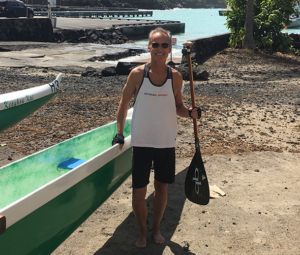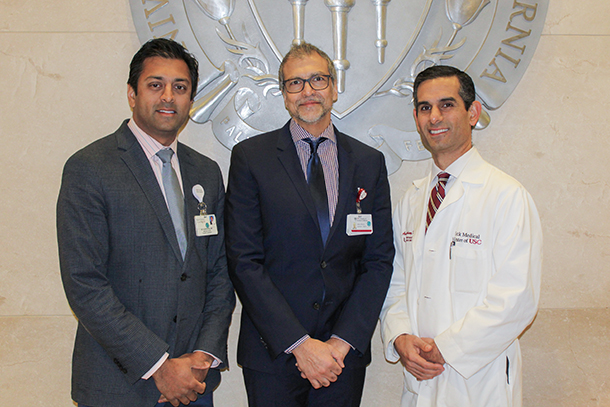A decade ago, Robert Turek was in perfect health — until, suddenly, he wasn’t. Today, though, he’s back in the outdoors thanks to a partnership between physicians and surgeons at Keck Medicine of USC.
“It couldn’t be my heart,” Turek remembered thinking at the time. “I was a runner. I ran every day. I worked out every day. I was sure it couldn’t be my heart.”
But Turek was having symptoms he couldn’t ignore: He couldn’t climb a flight of stairs without stopping to breathe. Once in the middle of his work day, he had to lock his office door and lie down to catch his breath.
When his legs started to swell, Turek knew it could be a symptom of heart disease. He went in for an EKG and was diagnosed with atrial fibrillation, also known as AFib, in 2007. AFib is a condition in which the upper chambers of the heart beat out of rhythm or don’t beat fully at all, “fluttering” or fibrillating instead. In addition to causing the fatigue and shortness of breath that Turek was experiencing, AFib can cause dizziness and chest pain, and greatly increases the risk for stroke and heart failure.
Dealing with the diagnosis
Turek worked with a cardiologist who put him on medication and tried cardioversion — shocking the heart to try to restore the correct electrical rhythms. He also worked with an electrophysiologist, who tried ablation, a procedure that involves scarring the heart to block some of the electrical impulses that cause the heart to beat erratically. Each time, Turek’s heart would beat regularly for a while, but then his AFib would return.
For a decade, Turek’s symptoms receded. He kept an eye on his heart and took a baby aspirin every day to reduce his risk of stroke and heart failure, and that was it.
But in 2018, Turek started noticing that he had to stop and catch his breath while hiking. He went in for a treadmill test and the administrator stopped him in the middle of it. Turek’s heart rate had spiked to more than 200 beats per minute. He needed to get to a cardiologist.
That’s when Turek called his daughter, Ashley Turek, MD, a pediatrician, and her husband, Ketan Patel, MD, an associate professor of surgery at the Keck School of Medicine of USC. In addition to being a highly rated plastic and reconstructive surgeon, Patel is a highly rated son-in-law. “I couldn’t ask for a better one. He’s terrific,” Turek said.
Family connection
Though he lives in Arizona, Turek regularly travels to Los Angeles to see his daughter, son-in-law and grandchildren. Patel got him in touch with Rahul Doshi, MD, associate professor of clinical medicine at the Keck School and the director of cardiac electrophysiology at Keck Medicine.
“I know the heart program here is great, so I felt comfortable sending him here,” Patel explained. “It’s reassuring to send a loved one to a place you know you can trust.”
The heart program is a part of Keck Medicine’s CardioVascular Thoracic Institute (CVTI), which was established to allow cardiologists, cardiac surgeons, vascular surgeons and thoracic surgeons to work together and personalize treatment programs to meet each patient’s needs. That’s exactly what happened in Turek’s case.
Doshi looked at Turek’s long history of AFib and knew that it would be hard to get him out of it. “The more you’re in atrial fibrillation, the more your body essentially remodels and wants to stay in atrial fibrillation,” he explained. “AFib causes cellular changes — how they function and how they’re electrically connected. Traditional ablations tend not to work, as you see was the case with Mr. Turek. So if you can’t solve the problem one way, what’s another?”
Doshi thought Turek would benefit from a minimally invasive surgical technique called the thoracoscopic maze procedure, one that is performed by only a handful of surgeons across the country — and by only two surgeons in the entire Los Angeles area.
“It’s so specialized that when my father-in-law told me about it, I had to look it up,” Patel said.
Cardiac collaboration
Armin Kiankhooy, MD, assistant professor of clinical surgery at the Keck School, specializes in the thoracoscopic maze procedure, so Doshi recommended him to Turek. That kind of a handoff is unusual in many parts of the world of heart care, where cardiologists and cardiac surgeons are often set up to compete with each other. Keck Medicine’s CVTI works differently: It’s expressly set up to allow cardiologists, cardiac surgeons, thoracic surgeons and vascular surgeons to collaborate.
“Every piece of heart care is important,” Kiankhooy said. “This kind of teamwork can be a huge benefit to the patient.”
Doshi agreed: “We can work together to craft a tailored procedure for patients — that’s very useful when you have a patient who has been in AFib for more than a decade and may be more difficult to treat.”
The thoracoscopic maze procedure is minimally invasive, using just three or four small incisions on each side of the chest instead of opening the chest completely. Kiankhooy uses a tiny camera to guide him as he makes a “maze” of tiny sections of scar tissue in the heart. These bits of scar tissue act as a barrier to stop the erratic electric impulses that can cause AFib and channel signals properly to the heart’s lower chambers.
After the surgery, Turek’s atria were able to beat properly, but his heart’s sinus node, the body’s natural pacemaker, was no longer functioning properly after a decade of persistent AFib. Doshi put in an artificial pacemaker to complete his treatment.
Getting good results

Robert Turek is able to rejoin his paddle club thanks to Keck Medicine of USC. (Photo/Courtesy Robert Turek)
Turek had come into CVTI with persistent AFib, experiencing symptoms 100 percent of the time. After seeing Doshi and Kiankhooy, he’s experiencing symptoms less than 1 percent of the time. Both doctors and the patient are pleased with the results.
“These types of hybrid approaches can be very successful for patients who have been in AFib for a long period of time,” Doshi said. “Dr. Kiankhooy’s expertise has been a godsend to me since he has started working here. It’s great to be able to work with a cardiac surgeon who has such an interest in arrhythmia.”
Kiankhooy was equally enthusiastic about the collaboration. “Dr. Doshi is just a rock star in the field. And his enthusiasm for patient care is just amazing. It’s such a pleasure to get to work with him.”
Turek is now feeling so good that he went on a trip to Hawaii in February where he planned on being as physically active as he was in the days before AFib.
“I’m 100 percent, now,” he said. “I’m a member of a paddling crew, and we go out at sunrise. I’m planning to go body surfing and swimming with manta rays. And I’ve already climbed a couple of difficult hikes. I’m not in AFib. I can do everything I ever did.”
— Lex Davis


